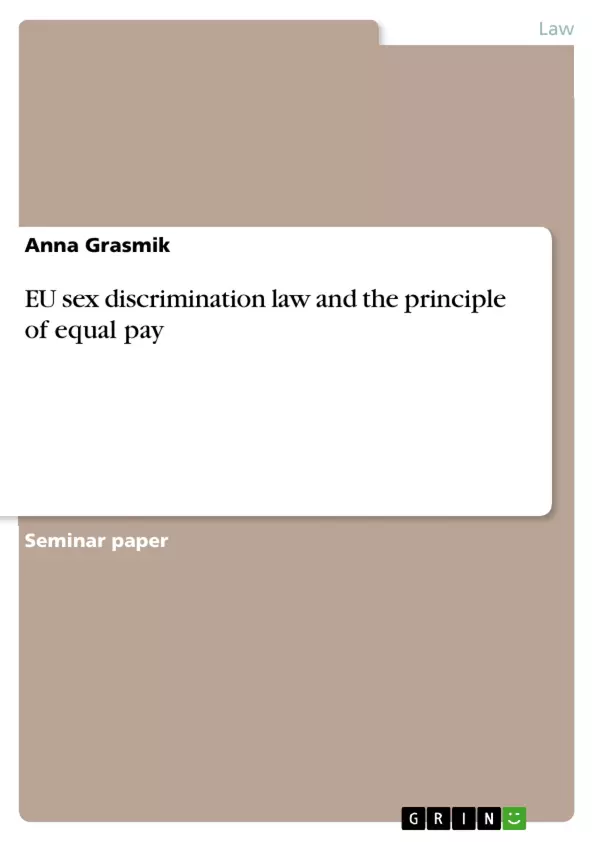The Council of Europe Commissioner for Human Rights, Thomas Hammarberg, said in his speech on 8th March 2011 „Every day women in Europe experience one of the most deep-rooted injustices - being paid less than a man for work of equal value.“
Equality between women and men is one of the objectives of the European Union. With the aid of legislation, case law and amendments to the contracts it had gradually succeeded to give emphasis to this principle and apply it in the EU.
This work will now try to show you this development. In the beginning, there will be a description of legal framework in the EU. This framework essentially bases on Article 157 TFEU and the Directive 2006/54. Afterwards follows the development of case studies by the jurisprudence of the ECJ in more detail. Keep on with the content of Article 157 TFEU with a closer look on the questions: What is pay? What is equal pay for equal work or work of equal value? When exists discrimination? What is the difference between direct and indirect discrimination?
“Well come forward, but still long way to go”: So the initial assessment of the agreement is to promote equal opportunities between women and men in the private sector. Is it right and more: is it enough? Let's see if this question can be answered at the end of this work.
Table of Contents
- INTRODUCTION
- LEGAL FRAMEWORK
- Article 157
- Directive 2006/54/EC
- ECJ DECISIONS: EQUAL PAY CASES UNDER ART. 157 TFEU
- 1st Case: C-191/03 North Western Health Board v. McKenna [2005] ECR I-07631
- 2nd Case: C-342/93 Gillespie and others v. Northern Health and Social Services Boards [1996] ECR I-475
- 3rd Case: C-313/02 Wippel v. Peek & Cloppenburg GmbH & Co. KG. [2004] ECR I-9483
- ARTICLE 157 TFEU
- History
- From Article 119 EEC to Article 157 TFEU
- Case Law
- Content of Article 157 TFEU
- What is "pay" in Article 157 TFEU?
- Widening the definition of “pay”
- Equal pay for equal work and work of equal value
- Types of discrimination
- History
- CONCLUSION AND INTERPRETATION
Objectives and Key Themes
This work aims to provide a comprehensive overview of the development of EU sex discrimination law with a focus on the principle of equal pay. It explores the legal framework governing this area, examines key ECJ decisions, and delves into the content of Article 157 TFEU, including the definition of "pay," equal pay for equal work and work of equal value, and different types of discrimination.
- The development of EU sex discrimination law
- The principle of equal pay for men and women
- Legal framework, including Article 157 TFEU and Directive 2006/54/EC
- Case law of the ECJ on equal pay cases
- Content and interpretation of Article 157 TFEU
Chapter Summaries
The introduction establishes the context of the work, highlighting the ongoing issue of gender-based wage inequality in Europe. It outlines the structure of the paper, covering the legal framework, ECJ decisions, and the content of Article 157 TFEU.
The legal framework section delves into the evolution of the principle of equal pay within EU law, from its origins in Article 119 of the Treaty of Rome to its current form in Article 157 TFEU. It also introduces the Directive 2006/54/EC, which aims to simplify and clarify provisions on equal treatment.
The chapter on ECJ decisions presents three landmark cases that illustrate the Court's interpretation of equal pay within the scope of Article 157 TFEU. These cases explore issues such as sick leave, maternity leave, and part-time employment.
The section on Article 157 TFEU examines the history and content of the article, including the definition of "pay," the principle of equal pay for equal work and work of equal value, and different types of discrimination.
The final chapter, Conclusion and Interpretation, is excluded from this preview to avoid spoilers.
Keywords
This work focuses on key concepts related to EU sex discrimination law, including equal pay, Article 157 TFEU, Directive 2006/54/EC, ECJ case law, gender equality, direct and indirect discrimination, and the definition of "pay." It explores the legal framework and its implementation in practice.
- Citation du texte
- Anna Grasmik (Auteur), 2012, EU sex discrimination law and the principle of equal pay, Munich, GRIN Verlag, https://www.grin.com/document/190764



